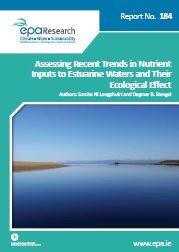Authors: Sorcha Ní Longphuirt and Dagmar B. Stengel
Summary: Research report 184 Assessing Recent Trends in Nutrient Inputs to Estuarine Waters and Their Ecological Effect

Identify pressures
The factors and processes controlling the export of diffuse and point source pollution from land to surface water have been the focus of a number of large-scale research projects in the recent decades, and, as a result, are well understood in the Irish environment. During the current project, load apportionment modelling was used to identify nutrient pressures in the Blackwater catchment. National load apportionment outputs were also determined through collaboration with the EPA-funded Catchment Management Support Tools (CMST) Project, which aims to model temporal nutrient transfers to Irish catchments. The research outputs have increased our understanding of nutrient pressures on Irish estuarine and coastal waters.
Inform policy
The responsibilities of the EPA in relation to the Water Framework Directive were amended in July 2014 with the publication of the S.I. No. 350 of 2014 – European Union (Water Policy) Regulations 2014. This gave significant new responsibilities to the EPA, including: reviewing the impact of human activities; drafting environmental objectives; undertaking catchment characterisation; preparing template river basin management plans; and compiling common programmes of measures. The project has fed directly into Tier 2 sub-catchment characterisation being undertaken by the EPA and can assist in the analysis of potentially significant pressures, the resilience of ecosystem, and likely response of estuarine systems to nutrient reductions. The work, which is on-going, therefore has helped inform management decisions in relation to targeting and prioritising mitigation measures which are socio-economically and technically feasible while ensuring the best environmental return.
Develop solutions
The selection of effective measures for estuarine and coastal waters will be predicated on having a well-developed understanding of how pressures interact with environmental factors and impact on biological receptors. The current project has helped to disentangle the biophysical and chemical factors that constrain/maintain the status of water bodies through the use of a simple box model which can be run using different scenarios of projected nutrient loads (agricultural and urban waste water), and climate considerations (flow regimes and winter/summer loads).